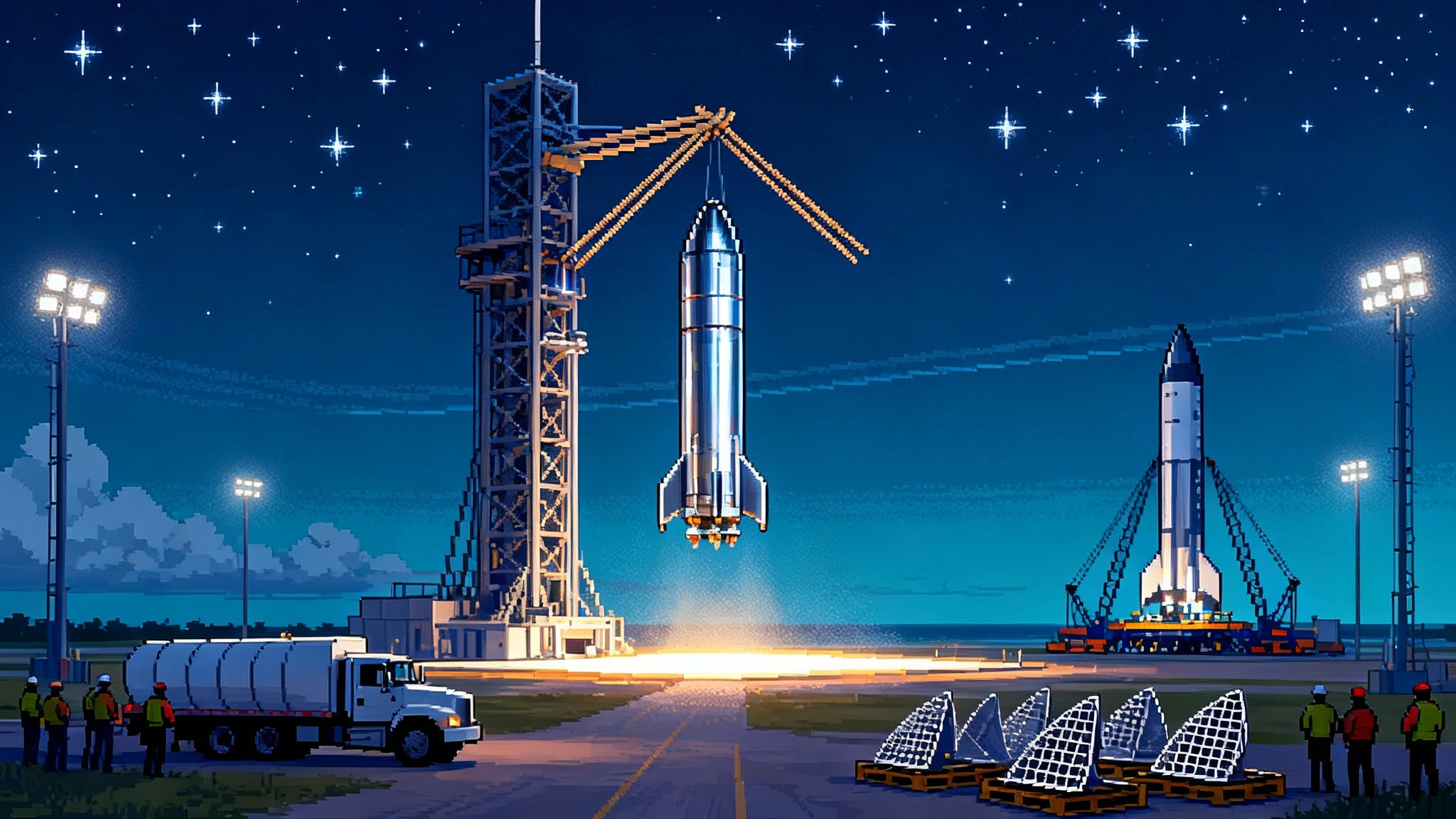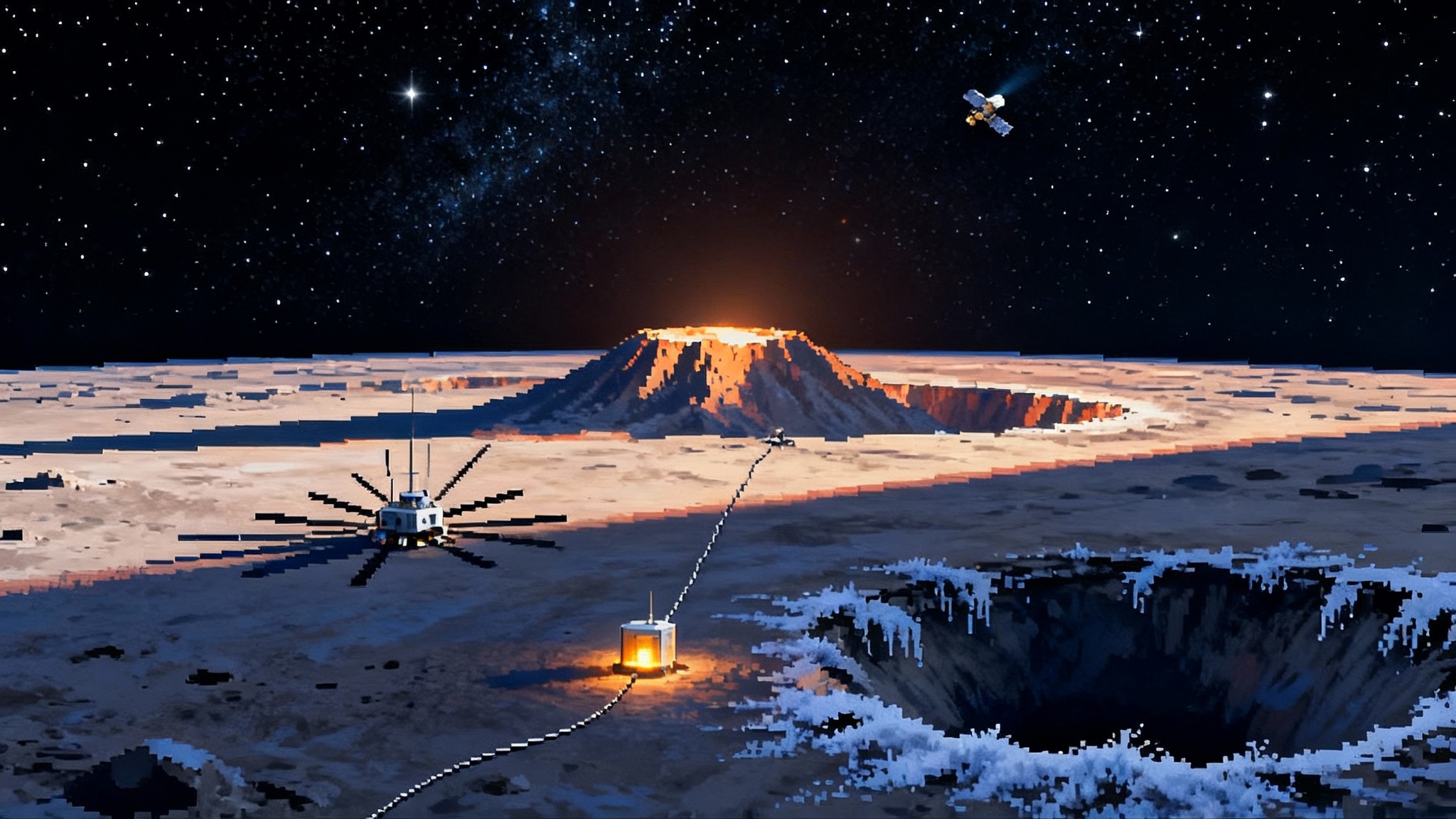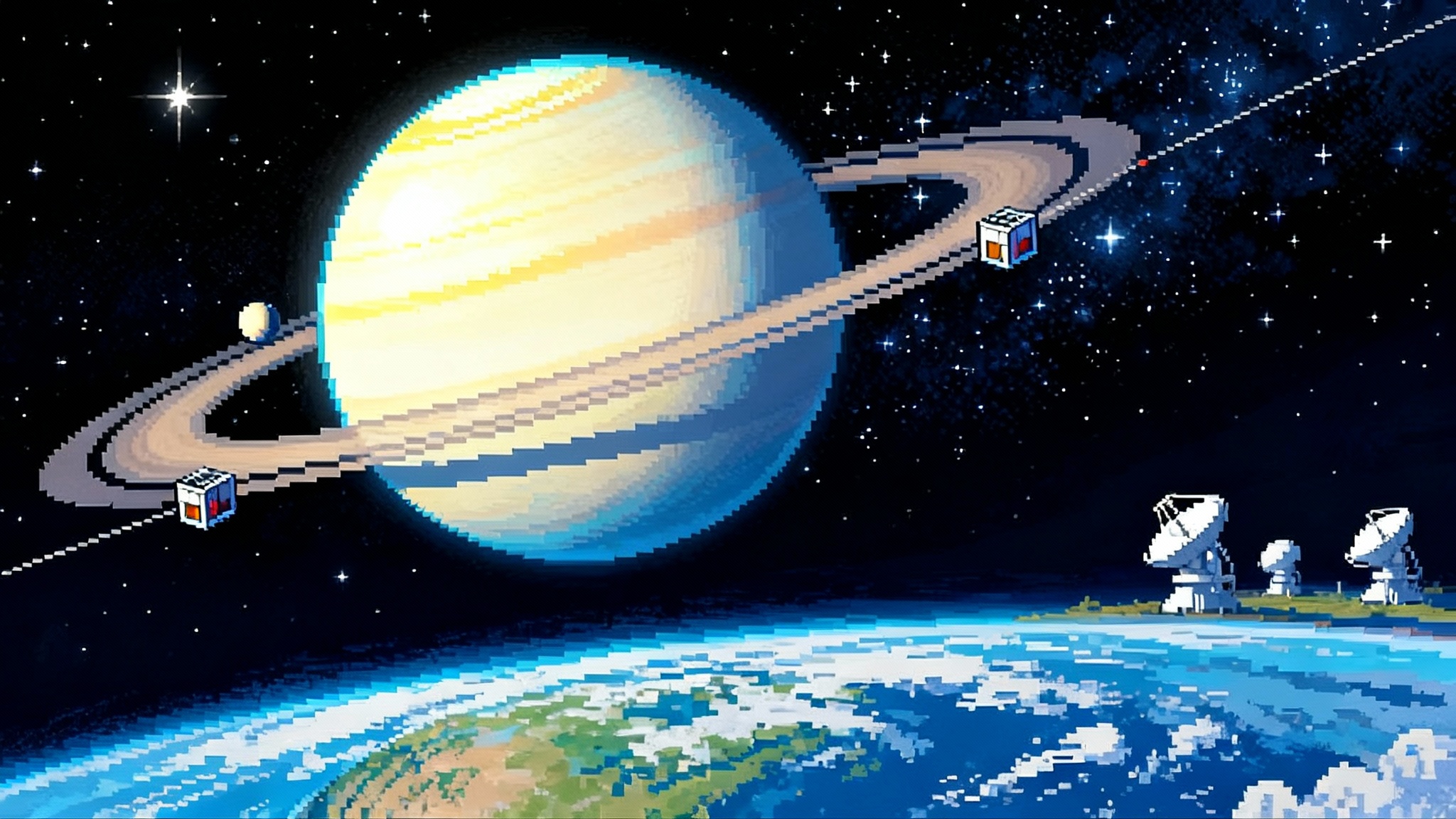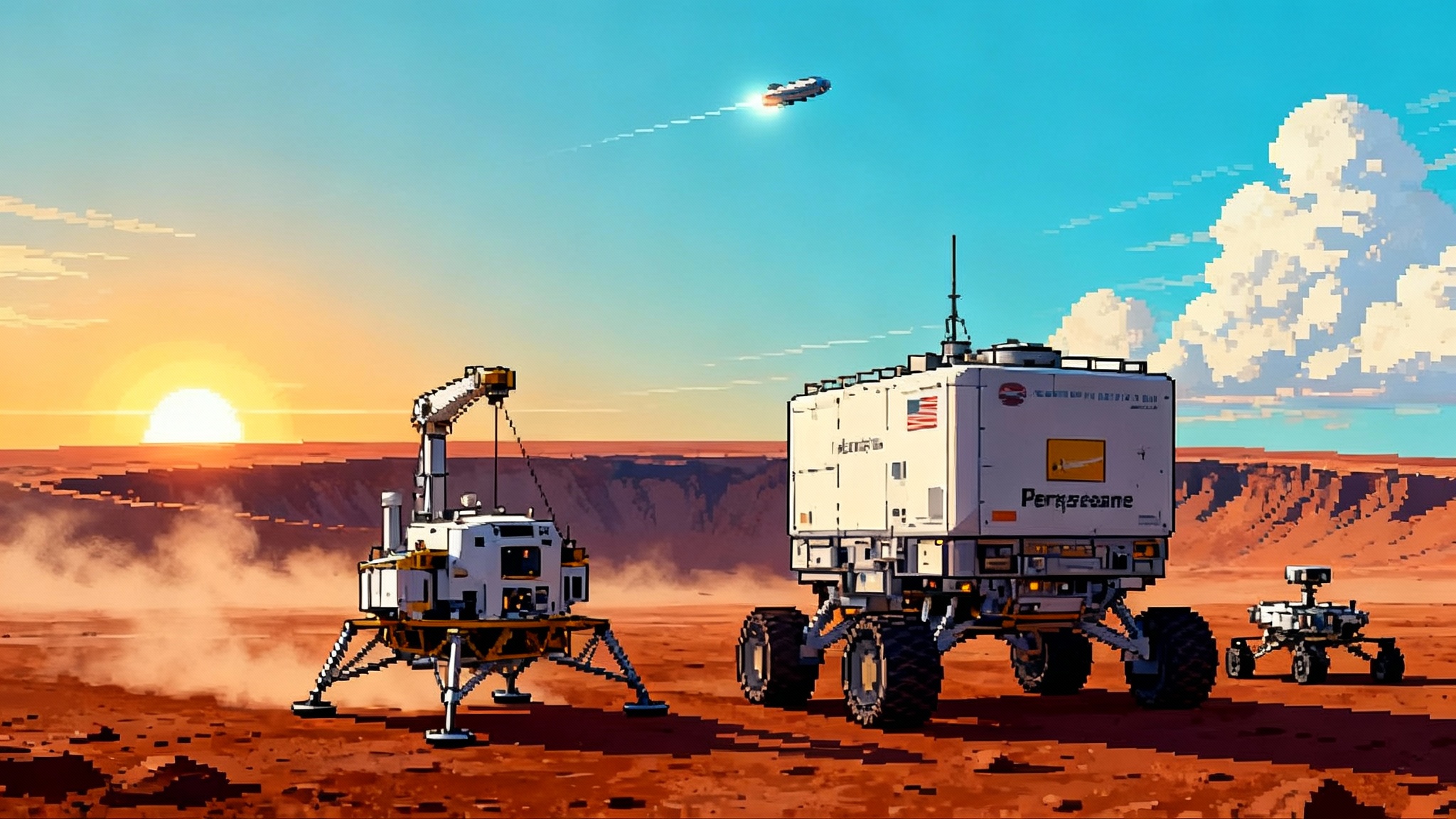IM‑2’s tipped landing proved lunar prospecting is here
In March 2025, Intuitive Machines’ IM-2 lander reached the Moon’s south pole, tipped over in a crater, and still ran NASA’s TRIDENT drill and MSolo tests. That messy success marks the start of practical lunar resource prospecting and a fast CLPS learning curve.
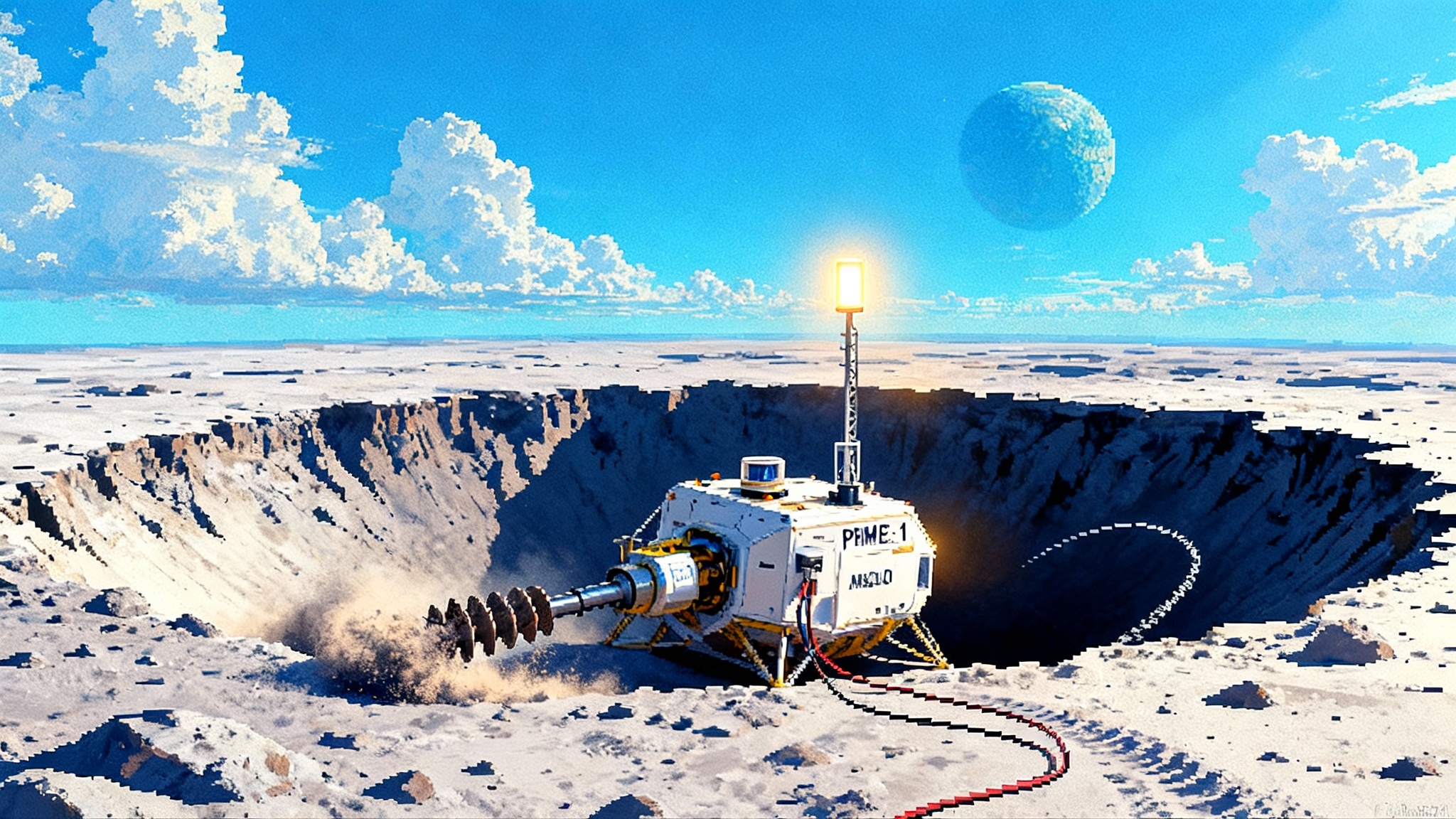
The moment the Moon became a worksite
On March 6, 2025, Intuitive Machines’ IM-2 lander, Athena, dropped into a small crater near the Moon’s south pole, came to rest on its side, and started working. Mission controllers hustled through a compressed timeline, powering NASA’s Polar Resources Ice Mining Experiment 1, better known as PRIME-1. Within the brief power window, PRIME-1’s two core instruments did what they were built to do: the TRIDENT drill executed commanded motions, and the MSolo mass spectrometer performed scans of gases released from drill cuttings. As NASA later summarized, these were genuine technology demonstrations in the harshest environment yet faced by the hardware, even if the mission ended early due to the lander’s orientation in shadow and cold. See the official recap in the NASA PRIME-1 mission update.
It was a strange tableau: a tipped vehicle, the most southerly lunar landing to date, batteries draining faster than planned, and yet drills turning and sensors sniffing for volatiles. That scene captured something larger than a single mission. It marked the start of practical lunar resource prospecting, not as a slogan but as an operational reality.
What IM-2 actually proved
Think of lunar in-situ resource utilization as plumbing and power first, chemistry second. Before anyone refines water into oxygen and hydrogen for life support and propellant, teams must show they can access the stuff where it sits, handle it without losing it, and measure it fast enough to beat the cold and the clock.
- The drill advanced. TRIDENT is a rotary-percussive system designed to break into tough regolith, bite in controllable increments, and bring material to the surface for analysis. The brief IM-2 window still allowed commanded operations and sensor checks, validating core mechanisms and thermal instrumentation while the lander lay on its side.
- The spectrometer sniffed. MSolo ran scans on gases liberated from material at the surface. Early indications pointed to mostly human-origin volatiles from the spacecraft itself, which is the contamination profile engineers expect and design around. The significance is that the measurement chain worked on the Moon, the data flowed, and the process for separating instrument signatures from native signals now has real lunar data behind it.
- The team adapted. IM-2’s orientation prevented full drilling depth, but operators executed a compressed test plan, captured as much performance data as possible, and closed the loop with post-test analysis. That capacity to pivot is part of de-risking, because lunar work is unforgiving and timelines collapse.
- Add one more proof point. Nokia and Intuitive Machines briefly powered the first cellular network on the Moon. The system came online for a short interval and transmitted operational data through the lander to Earth before power constraints shut it down. See what worked in Nokia’s lunar communications results.
The IM-2 story is not a cinematic triumph. It is better. It is a messy, engineering-grade success that reduces specific risks on the path to extracting and using lunar resources.
CLPS is doing exactly what it was designed to do
NASA’s Commercial Lunar Payload Services program is not a straight line to a single big payoff. It is a cadence of deliveries by multiple companies, each one shaving uncertainty off a long checklist: navigation and hazard avoidance in broken polar terrain, survival in extreme cold, dust mitigation around optics and panels, shallow drilling without boiling away volatiles, low-power communications, and data return inside short surface days.
Intuitive Machines has now delivered two landers to the surface, with IM-2 taking PRIME-1 to polar latitudes and operating despite a tipped posture. Firefly’s Blue Ghost added a separate thread of demonstrations relevant to surface power, thermal behavior, dust control, and navigation. Far-side operations will mature alongside lessons we explored in Chang’e-6 rewrites the Moon playbook, and commercial deep-space cadence echoes themes in New Glenn to Mars: ESCAPADE and the private interplanetary dawn.
Each first-order capability that works on the Moon unlocks two or three second-order operational options. After IM-2, teams can plan drill-and-sniff sequences with a real sense of how fast to run, what to log, and how to set thresholds for data triage when power is scarce.
Building a real polar water map after a setback
A credible water map needs two ingredients: wide-area orbital sensing and local ground truth. The original plan in 2025 called for a strong orbital contribution from the Lunar Trailblazer small satellite. That spacecraft failed shortly after launch and the mission was ended in July 2025. The loss was disappointing, but it clarified the near-term path.
Over the next 24 to 36 months, expect three things to fill the gap:
-
Better fusion of existing orbital data with on-site measurements. The Lunar Reconnaissance Orbiter’s neutron and ultraviolet instruments, radar datasets, and decades of polar lighting models can be combined with PRIME-1’s measurements, even if limited, to update probability maps of near-surface hydrogen and thermal stability zones. The value of PRIME-1 is not only in detection; it is in calibrating how regolith behaves when you disturb it.
-
International polar rovers and hoppers. Japan and India’s joint LUPEX rover targets late-decade launch windows with a 1.5-meter-class drill, neutron spectrometer, imaging spectrometers, and an exospheric mass spectrometer. China’s Chang'e-7 aims for 2026 with a hopper that can traverse from sunlit rims into pitch-black permanently shadowed regions. Think of a small machine scouting short, high-value paths where sunlight never touches the ground.
-
More surface experiments threaded through CLPS. Even missions not aimed at the poles will carry techniques that transfer, like dust removal by electrostatic methods, low-power radios for local mesh networks, or heat-flow probes that refine thermal models of regolith layers. Every improvement in thermal prediction helps plan how fast you must drill, how long you can hold a sample, and when you should switch from drilling to analysis.
A two-layer map will emerge: the top layer shows where ice is likely and accessible in the near surface along sunlit-shadow boundaries at the scale of a few hundred meters. The bottom layer shows how regolith and ice respond to drilling and heating at the scale of centimeters and minutes. Together, they tell engineers where to go and how to operate once they arrive.
Hoppers and the last 100 meters into shadow
Rovers avoid hazards; hoppers cross them. Intuitive Machines’ Micro-Nova hopper was designed to step down into shadowed craters on short sorties, then climb back to sunlight. It did not deploy on IM-2 due to the power situation, but the concept is moving from paper to fieldable hardware. Chang'e-7’s planned hopper reinforces that this is not a single-company bet. The physics favors hoppers for reconnaissance in polar terrain: flight times measured in seconds, no wheel sinkage, and the ability to land on slopes that would stop a rover cold.
Here is how a mature hopper adds value to resource prospecting:
- Recon first. Hop from a sunlit ridge into a shadowed pocket to take a fast neutron count and a multispectral snapshot of the regolith. If signals are promising, mark the spot.
- Guide the drill. Relay coordinates and local slopes to a drill-equipped lander, or to a rover that can edge closer to the boundary without entering shadow.
- Serve as a sampler. For pilot operations, a hopper carrying a small auger can acquire shallow grab samples from multiple pockets in a single surface day, enabling a multi-site assay instead of a single deep borehole.
LTE on the Moon and the rise of edge compute
IM-2 showed why on-surface networks and local processing matter. Even with a lander on its side, a compact cellular network briefly came online, reached an operational state, and sent telemetry to Earth. On a more typical mission, that same system would link a rover and a hopper to the lander and to one another, allowing them to send images, commands, and status without direct Earth links.
Cellular for lunar operations is not about video calls; it is about robust, short-range links that handle bursts of data from drills, sensors, and cameras with commodity hardware and well-understood protocols. Edge computing rides on the same logic. Several teams are flight-qualifying small data centers to process and store data on the surface during the narrow hours when sunlight and thermal conditions are favorable. The goal is not heavy artificial intelligence; it is fast compression, smart filtering, and local caching so that a mission can send only the most valuable bits home when the link is open. Put the two together and you get a practical recipe: run the drill, crunch the spectra locally, and send back the results while the Sun is still on your panels.
From tech demos to pilot-scale resource ops
The step after IM-2 is not a full mine. It is a pilot. On Earth, a pilot plant is the small, instrumented version of a process that proves you can run continuously, meet a throughput target, and stay within a power budget. The Moon needs the same discipline. A credible pilot for polar volatiles over the next 24 to 36 months would include these elements:
-
Site budget and boundary. Select a 20 by 20 meter patch that includes a sunlit-shadow interface and a safe approach path. Produce a modeled mass balance: kilograms of regolith disturbed, watts consumed, and liters of vapor expected.
-
Operations rhythm. Drill and assay three shallow holes, two in intermittent light and one in intermittent shadow, with drill bite sizes that look like production. Run the sequence twice to test repeatability.
-
Thermal capture. Demonstrate a heating method that limits volatile loss during sample handling. A simple example is an embedded core heater that raises a core’s temperature while MSolo-class sensors measure the release curve and a shroud traps vapor.
-
Water accounting. Show end-to-end accounting for any vapor detected. If anthropogenic gases dominate, document that and show how quickly they decay. If native water is detected, quantify detection limits and uncertainties.
-
Communications and compute. Keep the data close to the instruments. Use lander-hosted compute to downselect spectra and images and store raw data until downlink is available.
-
Dust and durability. Measure what drill cuttings do to solar output and optics and test a mitigation method on real dust, such as electrostatic cleaning or mechanical brushing.
The next 24 to 36 months, as a practical plan
Here is a realistic, conservative view of what should happen between late 2025 and late 2028 to move from demonstrations to pilots that can support early Artemis operations:
- 2026: CLPS flights to the lunar far side and mid-latitudes add infrastructure. Expect a far-side radio astronomy payload and a user terminal that helps commission relay services. These flights harden procedures for relay communications and for operating in areas without direct line of sight to Earth.
- 2026 to 2027: Hoppers mature. Whether on a Chinese, American, Japanese, or joint mission, a small hopper executing at least one down-and-up sortie into a shadowed pocket will validate tactics for polar boundary operations. That will change how landers select touchpoints and how drills are positioned.
- 2027 to 2028: Polar rovers with deeper drills arrive. The LUPEX rover and other international assets target the south polar region with instrument suites designed for volatile hunts. These missions extend ground truth beyond a single site and begin to define gradients in hydrogen content and regolith mechanics across distances of hundreds of meters.
- Continuous: Surface networking and edge compute become standard, not special. Cellular nodes on landers and short-range radios on hoppers and rovers form small, resilient networks. Flight-qualified compute boxes run compression, filtering, and quality checks before data goes home.
- Pilot design freeze: By late 2027, the community should lock the design of a pilot volatile-handling sequence that can be executed with the hardware already flying. That sequence would be the template early crews follow when they test production-scale systems near their landing zones.
What this means for Artemis operations
Early Artemis crews will not depend on lunar water for survival. They will bring what they need. But the first expeditions are the right time to validate a pilot resource chain: identify a patch of regolith with elevated hydrogen signals, drill in measured bites, heat and capture, analyze, and report. This is the same kind of risk-managed discipline discussed in NASA’s two-track bet to bring Mars samples home.
Success is not gallons of water; it is a closed mass balance, a repeatable sequence, and a power and time budget that can be met with the tools at hand. IM-2’s value is that it removed specific unknowns at the beginning of that chain. Engineers now have real lunar logging data from a drill and a mass spectrometer run on a fast-ticking clock. Communications teams have proof that a small cellular node can come up and transmit on the surface. Both results simplify planning for the next set of deliveries, where the question is not whether to try, but how to scale.
How to act on this now
If you are building hardware for the next two years of lunar work:
- Treat volatile management as a race condition. Set drill bite sizes, heater ramp rates, and sample routing to minimize time between cut and sniff. Instrument that timeline and publish it so others can design around it.
- Assume you will have to finish the most important test in minutes, not hours. Design your data path so the best five percent of your results are guaranteed to reach Earth even if the lander loses light.
- Build for cooperation, not isolation. Put short-range radios and standardized connectors on your payload. When a hopper, rover, and lander can share power, data, and commands over a simple local link, your mission survives more surprises.
- Quantify dust effects early. Your solar budget and your thermal plan must include dust deposition rates and cleaning cycles. Every watt preserved is another measurement completed.
The tidy lesson in a messy landing
Resource prospecting on the Moon will not start with a shining refinery. It starts with drills that work even when the lander is canted, sensors that read cleanly through a messy background, and radios that come alive just long enough to ship the essentials. IM-2 showed that this mindset works at the south pole. Over the next three years, the combination of CLPS deliveries, international rovers and hoppers, and on-surface networks will turn that mindset into repeatable pilot operations. The Moon has not changed; our approach has. That is the quiet beginning of a durable lunar economy.
